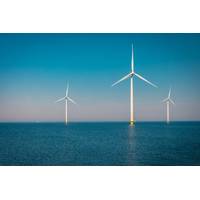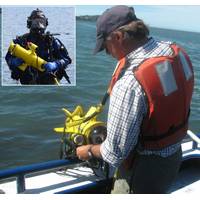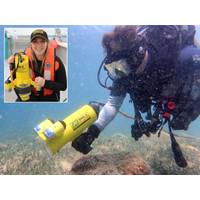
Floating Offshore Wind: New Seascape, New Challenges
lessons learned to floating wind towers, under development now. In the U.S., floating towers have been most closely associated with plans for new wind energy areas (WEA) in the Pacific, off of California and maybe Oregon and Washington. But important research is also taking place in Maine, at the University of Maine, because of deep ocean Atlantic areas there, and floating towers may also be used in the Gulf of Mexico.As most readers likely know, floating wind energy turbines offer the chance to take advantage of rich wind areas in waters too deep for fixed turbine construction. Floating towers, though

ASL Hires Chawarski as Biological Oceanographer
coastal and deep ocean ecosystems. He will be responsible for developing consulting services for ASL's ocean monitoring clients and will develop new tools for hydroacoustic studies of aquatic ecosystems.Previous to his appointment at ASL, Chawarski completed a Masters in Marine Biology at the University of Maine. During his studies he designed experiments to investigate the effects of marine protected areas (MPAs) on the recovery of groundfish stocks in the Gulf of Maine. He trained in acoustic analysis and provided new insights into the spatial distribution of herring spawning in inshore waters of

U.S. DOE Grants $21M for Offshore Wind Tech Projects
capable of supporting a 10+ megawatt turbine, using a scale model testing and simulation methodology previously used for oil and gas floating production facilities. The design is planned for installation and grid connection at one of Mayflower Wind’s lease areas in the Atlantic Ocean.The University of Maine will design, demonstrate, and validate a synthetic rope mooring for floating offshore wind turbines, which is expected to reduce the impact of offshore wind development on commercial fishing and reduce costs. The mooring system will be demonstrated on a full-scale floating offshore wind turbine

Offshore Wind – A Brief History
as they prepare and position themselves to play leading roles in the maritime logistics required to build out an entirely new energy industry.2013 – A critical project: construction of the first floating offshore wind turbine connected to the grid. This was a DOE partnership with the University of Maine, deploying a 1:8 scale, 20-kw concrete-composite floating platform wind turbine--the first in the world. This project will inform design and construction of two full-scale floating offshore wind turbines, work underway now, set for completion in 2021. The project utilizes patented

Floating Offshore Wind Turbine Design Passes ABS Review
The American Bureau of Shipping (ABS) has completed the design review of the Front End Engineering and Design (FEED) documentation for the VolturnUS, a floating offshore wind turbine (FOWT), developed by the University of Maine Advanced Structures and Composites Center. “UMaine is pleased that its innovative design became the first floating wind turbine concrete semisubmersible hull to be reviewed by ABS, and found to meet the ABS requirements,” said Dr. Habib J. Dagher, P.E, UMaine Composites Center executive director and principal investigator. “After 10

New Monitoring Platform Launched in Minas Passage
will help FORCE identify the best sensor settings and operating schedule for future data collection at the FORCE demonstration site. Dr. Haley Viehman, a post-doctoral fellow at Acadia University, will be analyzing the data upon retrieval. This work builds on her previous research at the University of Maine, where she studied fish interactions with an in-stream tidal turbine deployed in Cobscook Bay. “I’ll be examining how fish use the water column, and how their densities and depths vary with respect to time of day, tidal stage, and current speed,” said Dr. Viehman

Underwater Video Aids Scientists and Search Teams
Fishers video systems are the Rochester Police and Wayne Fire Departments in New York, Environmental Agency Abu Dhabi in the United Arab Emirates, Missouri Highway Patrol, Boston Police Special Operations Unit, Kuwait Institute for Scientific Research, Los Angeles County Sheriff’s Dept., University of Maine’s Darling Marine Center, Hartford Police Dept. in Connecticut, Arkansas Game & Fish Commission, Solano Dive Rescue Team in California, NOAA Great Lakes Environmental Research Lab, Roswell Fire Dept. in Georgia, Flathead Lake Biological Station in Montana, and Tampa Bay Aquatic Preserves

Plan Introduced to Drive US Offshore Wind Energy
to supporting development. Today’s strategy builds on DOE and DOI’s first joint offshore wind strategy, published in 2011. Since then, the Energy Department has allocated nearly $200 million to support three cutting-edge offshore wind demonstration projects led by the University of Maine, New Jersey’s Fishermen’s Energy, and Ohio’s Lake Erie Energy Development Corporation, and research and development investments in technologies that specifically address the opportunities and challenges across U.S. waters. Additionally, since 2010, the Department of the Interior

Underwater Video Aids Aquaculture and Marine Research
great and the camera and monitor are easy to operate.” A few of the many other environmental groups and marine researchers using Fishers underwater video systems are Envitech Middle East and Environmental Agency Abu Dhabi in United Arab Emirates, California Dept. of Fish and Game, University of Maine, Kuwait Institute for Scientific Research, Aquafact Environmental Consultants in Ireland, United States Environmental Protection Agency Atlantic Ecology Division, Arkansas Game and Fish Commission, National Oceanic and Atmospheric Administration’s (NOAA) Great Lakes Environmental Research



 February 2024
February 2024





